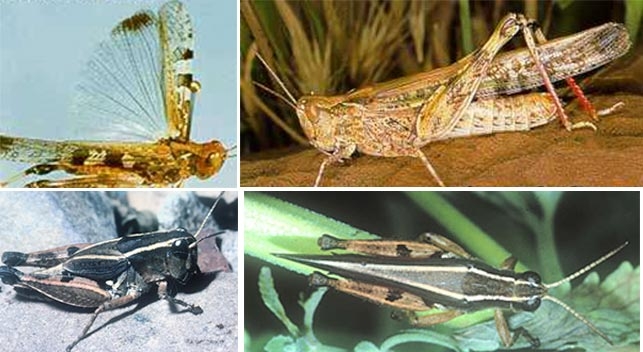It's been a difficult season for some growers having been affected by the recent bushfires or the heavy smoke that lingered for weeks. And just as that catastrophe was ending some growing regions received heavy rains, hail and even flooding.
It would be reasonable to suppose that an invasion by plague insects could be next, but maybe not.
Plague locusts and wingless grasshoppers have previously caused problems eating cherry tree leaves, but plague locusts are unlikely to build to sufficient number and become a problem this summer or early autumn.
Australian plague locust
The adult plague locust varies in colour from brown to green.
In profile the head is higher than the saddle shaped thorax, and the wings have a dark spot at the end. When spread, the hind wing is clear except for a spot which looks like an elongated dark smudge.
The rear legs have a reddish shank (tibia). When approached, individuals fly away 5 to 10 metres and turning to face you as they land. Some grasshoppers have similar habits but the plague locust has a particularly recognisable movement.
The February–April outlook is for generally low population densities to continue in most regions of inland eastern Australia.
Prolonged drought and associated poor habitat conditions have limited opportunities for successful locust breeding.
The heavy rainfall in several regions of Queensland and in parts of New South Wales and South Australia should produce favourable soil and vegetation conditions for locust breeding and subsequent nymph survival. This could produce a generation of nymphs developing in late February, although these are likely to be localised and at low densities as a result of the very low numbers of adults prior to the rainfall events.
Breeding could continue throughout February in some areas of Northwest and Central West Queensland where vegetation remains green, and an increase in adult numbers to medium densities is possible in autumn.
However, there is insufficient time for more than one complete generation before winter and multiple generations would be necessary for populations to increase to widespread high densities.
Regional habitats in other states are likely to remain generally unfavourable, with only limited breeding possible.
There is a low likelihood of high-density populations or widespread infestations developing during February or autumn.
Wingless grasshopper
The adult colour ranges from dark grey to brown but never green. Five colour-pattern forms exist. About 6% of adults of both sexes have a distinct white lateral body stripe. The thighs (femora) of the hind (jumping) legs have a distinct black mark mid way along their length.
Wingless grasshoppers are slender in appearance; their thoraxes are straight in profile while those of Australian plague locust and Austroicetes are typically saddle-shape in profile.
Wingless grasshoppers have a flat, pointed peg on their throats; Australian plague locust and Austroicetes do not have pegs on their throats.
Confusion with Australian plague locust and Austroicetes
Wingless grasshoppers are sometimes found in association with a range of other species such as Yellow winged locust, Eastern plague locust, Yellow bellied grasshopper, Mountain brown, Small plague grasshopper (Austroicetes cruciata) and occasionally Australian plague locust.
Adult wingless grasshoppers can be readily distinguished from the adults of the latter two species on the basis of their colouration, markings and the lack of a white ‘X’-shaped marking on top of the thorax.
Some confusion may arise because the shanks (tibiae) of the hind legs of wingless grasshopper are orange in colour while those of the Australian plague locust and some species of Austroicetes are reddish to pinkish in colour. However, the shanks of wingless grasshoppers do not have a pale-coloured collar while those of the other two genera do.
The short-winged adult form of the wingless grasshoppers is sometimes confused with late instar nymphs of these and other species of grasshoppers. However, examination of the direction of the wing venation on the wingbuds and the markings on the thorax will readily distinguish this species.
Wingless grasshoppers do not eat grasses—only native and introduced forbs.
There are two morphological forms (morphs) of this species. The short wing characteristic gave rise to the common name Wingless grasshopper. About 60% of adults have short wings (and are unable to fly). A variable proportion of adults have long wings (and can fly).
It is unlikely that an outbreak of either of these two insects is likely to cause a major problem this year.
See this article in Tree Fruit Feb 2020




















